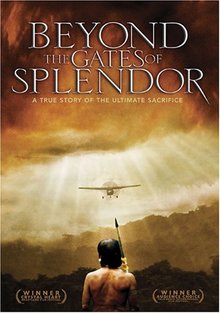| I want to go in a little different direction with this week’s movie. Instead of a classic movie or a more contemporary film that illustrates strong values and virtues I want look at the documentary Beyond the Gates of Splendor. This documentary is the factual and very well done basis for the new movie in theaters now, End of the Spear (both were produced by the same people).
This is a very intense film that tells the story of the massacre of five missionaries in the 1950s by a primitive tribe of people in the jungles of Ecuador, and the subsequent and near miraculous actions of the families of the men to continue the work that they began — with the same tribe and individuals that killed their husbands and fathers. |
 |
While the story is nearly forgotten today, it was a major sensation at the time it happened. While it took place in the 1950s there are enough people still alive today to offer first hand accounts of the events. There is also a lot of home movie clips shot by the men that have been worked into the film. These accounts and film clips are especially moving and compelling elements of the documentary. The time that has passed also provides an interesting perspective when discussing how similar and different the world is now compared to then.
Beyond the Gates of Splendor begins almost as a National Geographic program as it details the primitive life of the Waodani tribe. It is a violent life where murder is the expected and accepted way of settling disputes. With six out of every 10 adult deaths attributed to homicide, the tribe is spearing itself into extinction. Then the focus shifts for a time to the background of the missionaries and their families. The five men — Nate Saint, Jim Eliot, Ed McCully, Pete Fleming and Roger Youderian — will certainly challenge the image some may have of what a missionary looks like. They were all young, handsome, fit, energetic and resourceful. They were leaders in everything they did and drew people to them; truly the flower of a generation. They literally could have done or been anything they wanted yet their hearts were for people in distant lands.
The second half of the documentary details their efforts in Ecuador and Peru and their initial and ingenious method for making contact with the Waodani and early successes. All is well until a young Waodani, to cover his own misbehavior, lies to the tribe about the men, resulting in the fatal assault party. If the film stopped here it would still be compelling, but the real story is just beginning as the wives, children and friends of the men continue to minister to the tribe over the next generation, leading to a spectacular turnaround — so much so that at one point one of the missionary’s daughters is baptized at the same spot in the river where her father was killed, with two of the men from the group that killed him participating in the ceremony. My kids were completely mesmerized by Beyond the Gates of Splendor and while it can be emotionally challenging at times, it is a stirring depiction of vision, commitment and faith.
Points to Ponder:
- The Waodani society was based on two key values: egalitarianism and autonomy. No one could consider himself better than anyone else, but also, no one could get away with wronging another. With no institutionalized way of settling disputes, murder was the recourse of choice, often sparking a cycle of retribution. Does this sound familiar to other parts of the world or cities you know?
- What is your conception of the mission field today? Do you think it is the same or different from 50 years ago?
- What would you have done?
Questions to Answer:
- How did the men go about introducing themselves to the Waodani? Why did they do it this way?
- Nate Saint said “They’re not ready for ready for heaven, and we are,” in explaining why the men had decided not to use guns even to defend themselves. What did he mean by that?
- What were the circumstances that led up to the attack? Could they have been prevented?
- Why did the women return to the Waodani?
- What effect did all of this have on the Waodani?











